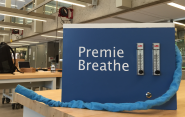Gonzalez Talks PremieBreathe at World Health Organization

Anjelica Gonzalez, the Donna L. Dubinsky Associate Professor of Biomedical Engineering, recently spoke to the World Health Organization (WHO) about PremieBreathe – a breathing aid for premature infants created at Yale.

PremieBreathe, a low-cost infant respirator that delivers warmed, humidified, and oxygenated air to reduce airway irritation and keep infants breathing normally, has been in the works since 2012 when the design for it originated in Gonzalez’s lab. At the WHO Global Forum on Medical Devices, held earlier this month in Geneva, Switzerland, Gonzalez discussed the progress that the PremieBreathe team has made in Ethiopia and the possibility of expanding use of the system to other countries. Gonzalez, who teaches Biotechnology and the Developing World, serves as Principal Investigator for PremieBreathe.
Her invitation to the event was connected to a $250,0000 USAID grant, the first of its kind awarded Yale. The PremieBreathe project was awarded the grant last year as part of the organization’s Saving Lives at Birth partnership. Working with WHO, USAID has been focusing on medical devices that can benefit hospitals in resource-poor cities, and deliver health care to populations under crisis.

Work on PremieBreathe is based on the idea of what’s known as “appropriate design,” a collaborative process between engineers and the people who will be using the device.
“When we refined the design of PremieBreathe, we worked with the hospitals in Ethiopia, where we still have collaborations,” Gonzalez said, adding that a validation study will be conducted there over the next year. “We spoke with their biomedical engineers, their physicians and nursing staff to figure out what makes sense in the context of their available infrastructure and support.”
That means, for instance, designing a system that can work with the region’s less-than-reliable electricity production and infrequent availability of sterile water.
“We’re very focused on design of devices for low- and middle–income countries,” she said. “Fortunately, the World Health Organization has highlighted us as someone who has contributed to that field.”
The PremieBreathe project started with a collaboration request from Yale’s Global Health Leadership Institute (GHLI) between Engineering (Gonzalez and Prof. Mark Saltzman in biomedical engineering, and Dr. Joseph Zinter at the Center for Engineering Innovation and Design) and the Pediatrics department at the Yale School of Medicine (Dr. Lei Chen and Dr. Linda D. Arnold). Gonzalez and Chen decided to focus on neonatal respiratory support in the clinical settings of Rwanda and Ethiopia. The Gonzalez lab undertook the task of engineering, design, and testing; Chen advised on clinical specifications. Also working on the project is a team of students and former students, led by Katy Chan, ‘15.
Gonzalez said attendees at the WHO event were particularly interested in how the system can be adapted to the governmental structures, resources and conditions of other countries.
Gonzalez said the issue of setting up the system in other countries is a complex one. Once PremieBreathe is better established in Ethiopia’s hospitals and clinics and the team has a proof of concept, she said, the next step is adapting it to other low- and middle-income countries, such as Uganda and Malawi. But conditions and resources vary from one country to the next, so expanding the use of PremieBreathe requires more than simply bringing the device to other nations’ hospitals.
“It means getting buy-in from the governments, ministries of health and from universities in the area so we can teach them to support and design their own devices like this one, and eventually get them used in the district hospitals and even in some of the smallest overburdened clinics there.”
Ultimately, the goal isn’t just getting PremieBreathe up and running in a particular environment, but ensuring its success for the long term.
“It’s important to make sure that these devices will be maintained,” she said. “We don’t want it there for six months and when a small thing goes wrong, it goes into what we call the medical device graveyard. We are focused on building devices that will help for a long time, we are thinking about sustainability.”

